|
Monday, May 2, 2011
Progress Notes
The Wright family descendents of Anthony Wright have been written about on our website frequently for a number of reasons including their early arrival to the area as well as the number of descendents who remained in the county to farm, maintain businesses and produce large families. The sons of Anthony Wright who settled here were James Lawrence Wright, Ezekiel Wright, and Hiram Wright. I have photos of James and Ezekiel but none of Hiram (photos 01 and 02).
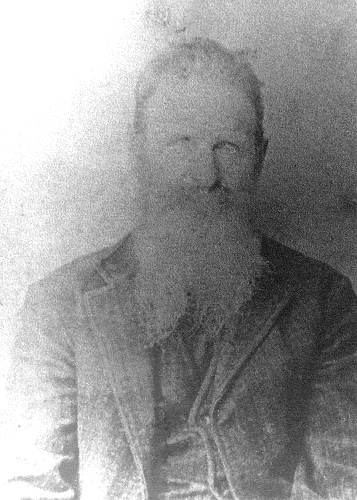
01 James Lawrence Wright 1818 - 1896
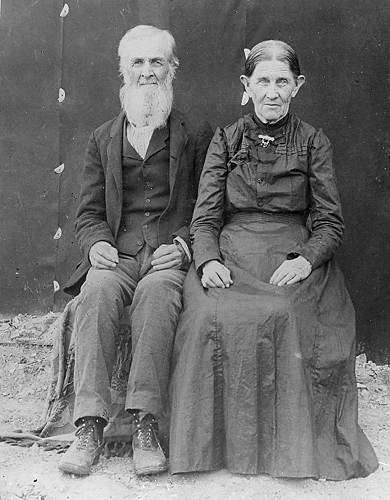
02 Ezekiel Harker Wright and Susan Barlow Wright
I have written about the Wright family many times including all three brothers’ families. You can refer to these previous URL locations for the previous Wright family narratives (photo 03).

03 Wright References on Website
Click image to see complete listing in PDF format
Most of the Wright family stories have featured the descendents of James Lawrence Wright since they seemed to have produced more progeny which stayed in Miller County than the two other brothers. One of the sons of James Lawrence, Green Lee Wright, had a son who moved away early in his life. His name was Charles Wright (photos 04 and 05).
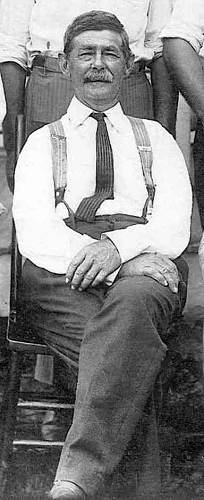
04 Green Lee Wright
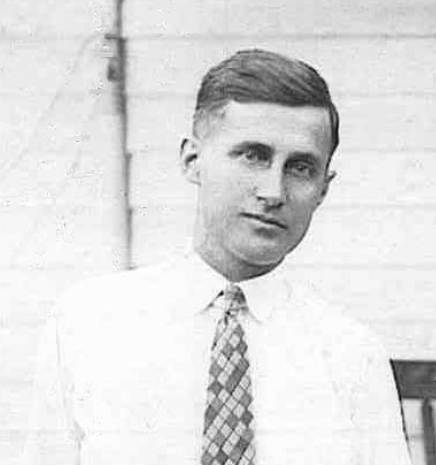
05 Charles Wright
I had wondered several times where Charles went and what career he pursued. Bamber Wright, grandson of Green Lee, told me that his cousin, Merle Wright, was Charles’ son, and that he presently lived in the country of Mexico. I contacted Merle by email and he told me he had just finished his autobiography (photos 06 and 07).
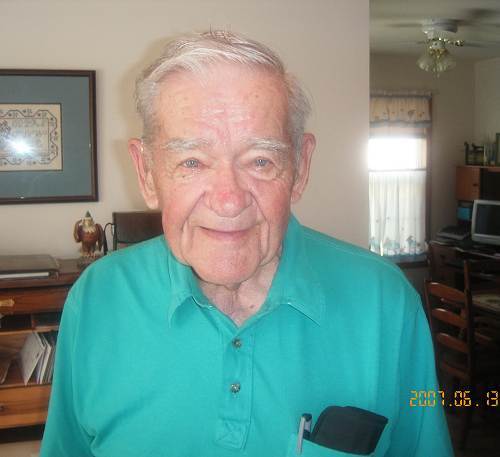
06 Bamber Wright
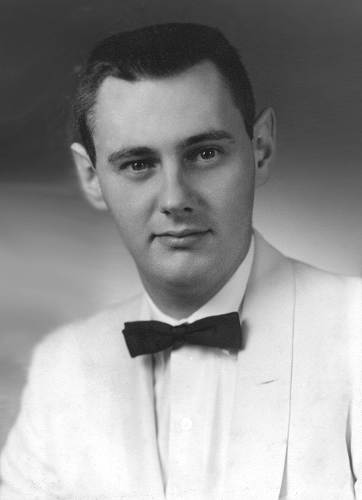
07 Merle Wright
Merle emailed me his autobiography and after I read it I felt it was interesting for a number of reasons. First, in discussing his childhood, Merle’s autobiography also gives the history of his father Charles after he left Miller County. And second, I thought Merle’s own history was interesting and is another example of the successful lives of individuals whose roots come from our county.
So, this week I will present Merle’s memories of his father, Charles Wright, as well as Merle’s own story of his accomplishments as well. Near the end of Merle’s narrative he briefly mentions that he recently completed chemotherapy for esophageal carcinoma diagnosed in 2009. This is not his first battle with cancer. In 1996 he was treated for cancer of the kidney. I am grateful that Merle took the time to write his story for our Miller County community to read.
Merle Glen Wright
Although I am not much of a genealogist, I know that I am of the fifth generation of the Wright family in Miller and Cole Counties and the fourth generation of the Kouns family from Callaway and Camden Counties, Missouri.
My paternal grandparents, Mary Emma Boyce and Green Lee Wright, lived on a 300-acre farm three miles north of Tuscumbia on the Little Saline Creek. This was part of the land patented and purchased outright by my great grandfather, James Lawrence Wright, and his wife, Elizabeth Mace (Thompson) Wright, in about 1856. My father, Charles Isaac Wright, (December 1893—April 1976) was the youngest son of Green Lee and Mary Emma (Boyce) Wright. He had four brothers, Clarence (otherwise known as 'C.B.'), Otis, Richard, Homer Lee (my favorite, and Bamber Wright’s father) and one sister, Gertrude.
Note: Here is a photo of Green Lee Wright and his family (photo 08):
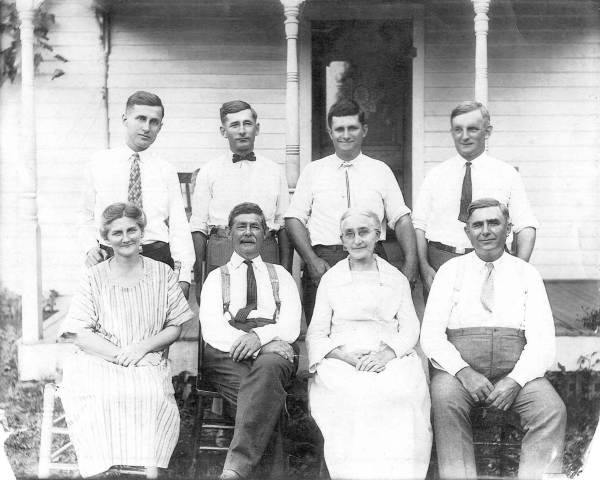
08 Family of Green Lee Wright
And here is the caption for the photo:
At the back of the photo are left to right Charles, Homer Lee, Richard, and Otis. In the front of the photo left to right are Gertrude, Green Lee, Mary Emma Boyce Wright, and Clarence Boyce Wright.
By the time I can remember, my uncle Otis and his wife, Aunt Maude, lived on the farm and ran it for my grandparents. I stayed with them and enjoyed this wonderful place, with a large spring on the property that was good to drink from, and kept watermelons cold. I have more summertime memories of Miller County than of my home in Boone County. My uncle "C.B." Wright was president of Anchor Milling Co., and his son, Homer Clay, worked in the office (photos 09 and 10).
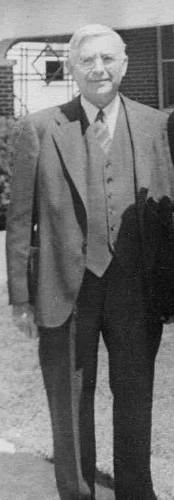
09 Clarence Boyce Wright
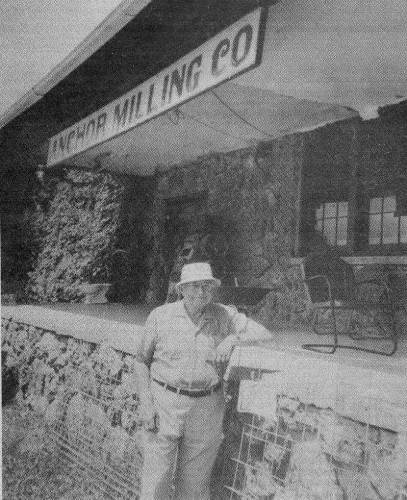
10 Homer Clay Wright
My uncle Homer ran the mill and his son, Bamber, drove trucks selling and delivering the milled products. I wanted to stay at Uncle Homer’s when I visited Tuscumbia and Miller County. It seemed like there was always something interesting happening there. I also liked to be around the machinery of the mill and go with Bamber on his deliveries. I guess this is where I learned to efficiently load and pack items for a trip on the road. I became good at this and taught my sons. Now they are better than I am.
My maternal grandparents were Dr. D.H. Kouns and Lena Churchill of Tuscumbia. Dr. Douglas Hord Kouns, whose parents were also born in Missouri, was born and raised in the Missouri river town of Cote Sans Dessein in Callaway County, south of Fulton (photo 11).
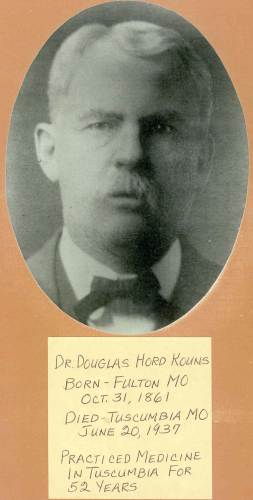
11 Dr. Douglas Hord Kouns
He was the longest practicing physician in Miller County history. I only have one memory of him. I was about three years old when I went with him to his office on a nice summer morning. It was upstairs in the old Bank of Tuscumbia building down under the hill. I sat on his knee and we played Doctor and patient.
Lena was born at Linn Creek in Camden County. There were six children, my mother, Pauline Kouns Wright (November, 1896-March, 1976) Mary, Clara, Hazel, Churchill, and Clarence.
Note: you can read the story of Dr. Kouns and his family at this previous Progress Notes.
Before her marriage, my mother drove the car for her father, Dr. Kouns, to make house calls in Miller County. She had been to Synodical College in Fulton, MO, where she studied piano. My Uncle Clarence Kouns, a freelance writer and a bachelor, was living with Grandmother Kouns. When I was, about eight or nine I remember going with him to Haunstein’s or Nichol’s store for ice cream and soda. Then we would get the mail from the post office box next to the store, where my father’s brother, Richard, was a rural mail carrier. I went with him on the rural route a few times. I liked to help sort the mail and put it the boxes
Note: Here is a photo of young Homer Lee and Richard Wright (photo 12):
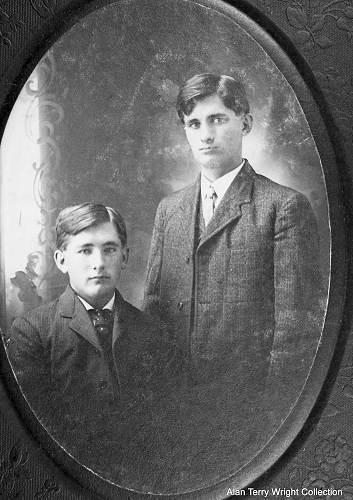
12 Homer Lee and Richard Wright
I was born September 1, 1933 in Mexico, MO, an only child. Our family home was at 308 West Sims St. in Centralia, Boone County, MO, and a prairie village of about 2,000 people. I had my share of childhood bumps, bruises and sickness, including mumps and measles. I once mashed the end of my left middle finger badly enough that it required Dr. Turner to sew it back on. It finally healed, but was very cold in the wintertime. A few years later, I was knocked down while playing an outdoor hide, seek type game, and found that I had dislocated my shoulder, which took several weeks to heal.
My father went to Knox College in Galesburg, IL, for one year or more before seeking work in management or accounting. He had been a traveling auditor for the Wear-u-Well shoe company and tried other jobs before he went to Alliance, Nebraska, then Erie, Pennsylvania in the lumber business. He got a job back in Missouri as manager of the La Cross Lumber Company in Centralia. He purchased and operated two farms, which were located two and four miles from Centralia. He contracted with other farmers for the row crops, but had livestock that he looked after. We lived at the edge of town next to the Columbia Branch Railroad. I liked to go out and watch the trains from a very early age. My father thought I needed to learn more about farming and I was driving a tractor at 10 years of age. I think I was 13 when I started driving the family car.
On my 6th birthday, Sept 1, 1939, Adolph Hitler invaded Poland. I remember that my father, being a World War I veteran, stayed glued to the radio all day and my mother would not serve my favorite birthday cake, Devils food with white coconut icing, until he would join us. My mother and father would play family board games or cards with me and read stories. When I was four or five years old, our family had a dog named Sandy, who had a mind of his own. Late one summer afternoon, the dog went for a walk and I followed him for eight or ten blocks. It was getting dark and I did not know where I was. A woman stopped to talk to me and ask if I needed help. She knew my parents and made a phone call for them to come and get me. They picked me up and took me home. By this time, it was around nine o’clock. Mother and dad had a long discussion as to what my punishment was to be and when.
The war caused a shortage of fresh meat, canned goods, shoes, gasoline, tires, metal toys and electric items. Only poor quality substitutes were available on some things. My father, being very resourceful, had an employee at the lumberyard make many different size wood blocks for me to play with and I enjoyed doing so for hours on end. I remember standing in line with mother to get ration cards for the many controlled products that we used in everyday life. The farming operation allowed us to receive more gasoline and tires with a ‘B’ gas card. My father also had a victory garden and my mother canned fruits and vegetables. I had a pet cat that helped my father in the garden. We gave her the name Gardener. I had a little black Scotty dog named 'Toots.' She could not go in the house, so we played out in the yard.
Sometimes we waited for the postman to deliver our mail so I could put it in the box, or she watched me make things in the sand box dad had made.
Note: Merle sent me some photos of himself at about the age he would have been during this part of his narrative (photos 13 and 14):
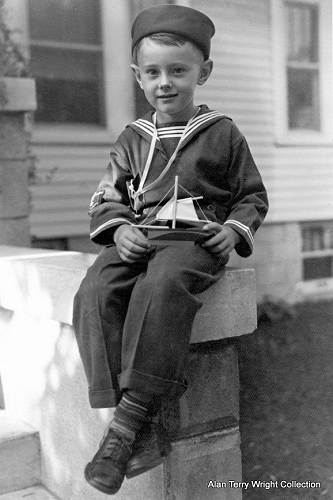
13 Merle G. Wright
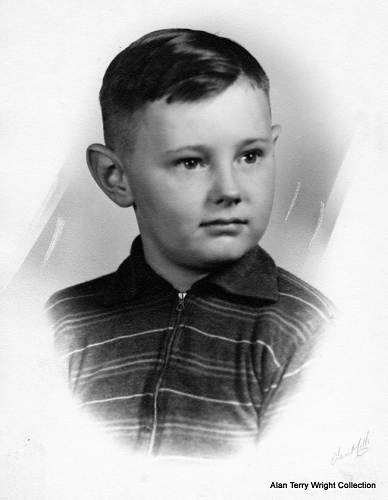
14 Merle G. Wright
Our family had a milk cow and made butter from the cream. We raised chickens, with some being kept for laying eggs and others became Sunday dinner. We had some pigs, and in winter, butchered one and sugar cured the hams. Dad also butchered a small Angus cow, so there were plenty of hamburgers from which I learned to make hamburger sandwiches. In school, we were asked to bring 10 or 25 cents a week for war savings stamps. I had a Shetland pony named “Sid”, but dad sold him to help the war in Europe. Many horses, mules, and ponies were shipped to Europe from the mid-west to work wherever needed. I had to walk to school most of the time, which was about one mile. My friends and I took routes we called a “secret passage”. After school, and on weekends, I liked to build model airplanes and fly them. I got interested in “crystal radio” and made one that had earphones to listen to far away transmitters.
When I think back to my school days and recall people with which I crossed paths, I remember some that I still know today, dating back to grade school in Centralia. Phil Chance, now deceased, from first grade to him being best man for my wedding and me for his. Harold Ward another person from 1st grade and we remain friends today. Also Kenneth Harter, from fourth grade, and now we both winter in Mission TX.
I have a story to tell from a happening with Phil and Harold. Phil and I were interested in the study of chemistry. I had a chemistry set in a small basement room where I learned about many mixtures and compounds, including how to silver plate items with chemicals and a battery. In experimenting with different things, we found explosives to be the most fun and tried different ones. One afternoon, we went to a hardware store, where we purchased a box of dynamite, much more than we needed, but it did not cost as much as fireworks. I do not remember any big stories that we had to invent to say why we needed that much dynamite as the purchase went very smooth. That evening Harold, Phil and I went for a drive about a mile from town on a dirt road where we stopped and placed a half of stick of dynamite on the road. Then lit the fuse and ran back fifty yards or more. A loud explosion happened, but only scattered the dust. We then drove back to the center of town where I lit the other half stick, threw it in a ditch, and drove off. Of course, the small town police were not busy and found us shortly after, with our supplies. We were all given a ticket for disturbing the peace. A few days later, a police court was held in the feed store that the judge owned. I was fined $15.00 and 4.50 costs, and the others $10.00 each. My father was the only parent that attended. I think he was unhappy with me. I cannot remember if I received other punishments, but I had to work to pay the fine. I do not view this as an act of rebellion, but I think this is about the same time that I started the bad habit of smoking cigarettes. Looking back to childhood and my teenage years, I think my parents were strict with me, for my own good. I had to be home by ten o’clock on week day nights during the school year and midnight on weekends.
In July of 1940, I went with my father to the post office to buy stamps. The postmaster showed me a new issue stamp commemorating Wyoming statehood.
My dad bought that three-cent stamp for me and it started a lifelong hobby of collecting. I began with collecting stamps of the world, but soon shifted my focus to U.S. only. At about the same time, I started collecting coins by trying to find Indian Head pennies. Later, I collected silver quarters while I was in the coin machine business--the real silver ones still in circulation in the 1980's. I became a dealer of U.S. stamps, going to auctions in Chicago and St. Louis. I have downsized most of my collection, but still do some selling from old inventory that I do not want or need.
My father gave me his old 22-gauge Remington rifle and taught me to use it. I remember hunting squirrel in the Osage River bottom with my Uncle Homer and his little dog, 'Hugo.' I tried fishing only one or two times that I remember, but soon discovered there was not enough action in this sport to suit me. In the late fall of 1949, I found a 16 gauge Ithaca shotgun on one of the farms. The gun was never claimed and I used it for many years. I enjoyed hunting quail in Miller County with Homer C. Wright, pheasant in Nebraska and Kansas, goose & duck in north Missouri, deer around the Lake of the Ozarks, and elk in Colorado and Idaho. I joined a Wildlife Club in Arkansas and hunted wild boar. I got one, too, but it was not as good to eat as I had hoped.
At age 12, I joined the First Christian Church where my father was an elder. I received my first new bicycle for my birthday and joined the Boy Scouts of America. I liked being a Boy Scout and spent many years learning camping and earning over twenty merit badges. The sponsor of Scout Troop 90 purchased a used, pre-fabricated building from surplus property at Ft. Leonard Wood, which was reconstructed into a cabin by men and older scouts, including me. It could sleep 25-30 people and had a large fireplace. The cabin sat on a hill above the creek known as the South Fork of the Salt River and had a view of one of Missouri’s only covered bridges, known as Union Bridge. I became Quartermaster for the troop, in charge of books, supplies, and tents, along with other needs for all. I trained to work on the staff of summer camps and in 1950, I served on the staff of the B.S.A. National Jamboree at Valley Forge, Pennsylvania.
I attended high school in Centralia where I learned to play the clarinet and was in the concert and marching bands. My senior year, I enjoyed playing in a dance band. I continued playing in the military and was in the Aviation Cadet Marching Band at Harlingen Air Force Base. For sports, I was on the football team for two years. I got my first real job as a “soda jerk” in a drug store working with my friend, Harold Ward, until I was 16 at which time I became a delivery boy for the largest grocery store driving a new pick-up truck. In the summer of my junior year, I was selected to go to Boys State of Missouri, a one-week seminar that teaches government and politics. In my senior year of high school, my father bought the Centralia Wholesale Candy Company. This was the beginning of my business career. Dad taught me how to order from the manufacturers, receive the shipment, inventory it, and the bookkeeping to pay for it. I would load our car with boxes of candy bars, gum, peanuts and other bag items, which I then sold to small stores in a 25-mile surrounding area. After graduation from high school in the spring of 1951, I worked as a counselor at the summer camp of the Chicago Boys Club, located in Wisconsin.
That fall I enrolled in Westminster College, Fulton, MO. I was the third generation of my family to attend, after my Uncle Fred Haunstein and my grandfather, Dr. D.H. Kouns (photo 15).
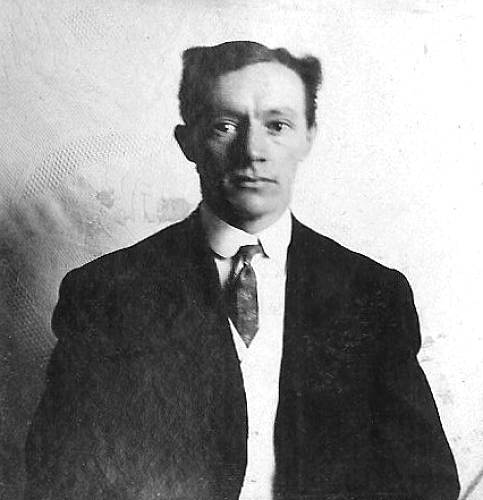
15 Fred Hauenstein
I joined Phi Delta Theta, a social fraternity that became a benefit to me in business many years later. I learned more about the ways of the world, and where I fit into it during the next two years than any experiences, before or after. For transportation, I had a good Model A Ford. I had not identified a major course of study after two years, and my friends were being drafted for the Korean War. I chose to enlist in the U.S. Air Force. I qualified to go to navigator school and went to Harlingen, TX. Before I finished training, the war was winding down and I received an honorable discharge after only two years. One of the biggest disappointments of my life was not becoming a commissioned officer, on flying status, in the U.S. Air Force. I returned to Columbia, MO and enrolled in the University of Missouri, where I received a degree in social work and business. I had enough time left on the G.I. bill to get my airplane pilot's license, and have now logged over 1500 hours, as pilot in command. I have flown from coast to coast--including learning mountain flying and instruments. Flying my own plane was a real joy for both business and pleasure. I am a proud member of a nation-wide pilot’s organization named the Quiet Birdmen.
In 1943, my grandmother Kouns took me to see all the floodgates open at Bagnell Dam. That was the year of a great flood on the Osage River. I remember riding in a motor boat, with Uncle Homer to his farm and around Tuscumbia, much of which was under water. We crossed Goose Bottom, and on to the Anchor Milling Company, to see what the flood damage was. Beginning with that experience, I have had a lifetime fascination with the Lake of the Ozarks.
Before my last year at the University of Missouri, I bought a sixteen-foot boat with a 25 H.P. outboard motor and a new 10 by 35 foot house trailer. I took them to the Lake of the Ozarks, across the main channel from the Tan-Tar-A Resort, where I rented some land on a little point at the end of a cove. Here I had my first experience with water skiing. I became good at it and later taught all of my children. In the fall, I took the house trailer back to Columbia and rented it to a student couple for the school year. The next June, I did the same thing by taking it to the Lake and back again. It made a nice lake cabin, with a hot water shower.
In my senior year at the University, I was elected to a seat on Student Council of the Student Government Association. I then received the honor of being the first student judge of the University Traffic Court which was a new way the faculty found to involve students in policy decisions.
In the spring of 1957, I married Patricia Barley, who had come to the University of Missouri to study journalism from Colorado Springs, CO. She completed her education and received a master’s degree in Social Work. She was employed by the Mid-Missouri Mental Health Center and worked for many years as a psychiatric social worker. We had three children: Timothy, born Aug. 1959, now in Boise Idaho; Vincent, born Jan. 1964, now in Austin, Texas; and Emily Wright Hiles, born Aug. 1965, now living in Glenwood Springs, Colorado. When Vincent was born, we moved from a small house on West Worley to a new and larger house at 215 W. Parkway, close to the center of Columbia. This house came complete with a bomb fall-out shelter, which we stocked for an emergency in case the Soviets mounted a nuclear attack on Columbia. A few years later, I built a large swimming pool, which several neighbor children enjoyed, along with our own. A swimming pool allows one to gain many new friends.
I graduated from the University in January 1958, and became an agent for General American Life Insurance Co. of St. Louis. In less than two years, I was dissatisfied with working for others and purchased the Italian Village Restaurant on the University of Missouri Campus. My partner in this business was George Petrakis whose work was his hobby, as well as his occupation, and thought I should do the same. I learned a lot from George, and I consider him something of a mentor in my business career. However, my father was always my real role model. I liked, and to this day, hold in high esteem so many of the things he did or the ways he did them. Like many sons, I adopted dad's political views. He was a kindly, patient man. He had an appreciation for all creatures, large and small. One of the little things I recall about him was that he named all the barnyard animals, as well as the pets. Peculiarly, when a train was going past, at home or at the farm, he would stop what he was doing and count the number of cars, freight or passenger.
I developed a vending machine route of cigarettes and candy by buying two companies that I put together and operated out of my home. I used my experience from the wholesale candy company that my dad had bought several years before to help this endeavor and it led directly to my next project. I traded my interest in the restaurant for half interest in a coin machine amusement company, and merged the vending business with it. This was a service business with over 400 machines on location. At times, I was called out late at night to repair a broken machine or to bring more coins to the various bars and restaurants. There were times that I had several hundred dollars worth of coins with me and the people on the street were told clearly by business owners NOT to bother the "vendor man." Nevertheless, I obtained a concealed weapon permit and carried a police revolver. I also served on the Auxiliary Police Force of Columbia, where I rode with an officer on duty and performed the duties of a regular police officer.
I had learned about American Saddle bred horses as a boy, when my father was president of the Centralia Horse Show. In 1962, I was elected Chairman of the Boone County Horse Show, which is the best county show in the State, presenting many different breeds, and is a forerunner each year to the Missouri State Fair Horse Show. To this day, I really like to see horses of all breeds.
The following year, I was appointed to the board of directors of the Boone County old folks home. I held the office of President of the Board for eight years, during which time we built a new sixty-bed building next to Boone County Hospital, and named it Boone Retirement Center.
I also became a member of the American Legion, Elks Club, and V.F.W. and the Boone County Historical Society.
In 1964, I took up the sport of snow skiing in Colorado and continued that sport until last year. I joined the local ski club and went on many weekend trips to Colorado and Utah, including one trip to France. I served the club by being on the board of directors and served in all of the offices, including president for two years. The Columbia Ski Club belonged to the Flatland Ski Association, which joined ski clubs from the states of Missouri, Kansas, Nebraska, and Oklahoma together to promote better relations with the ski areas. I became president of the Association for two years after I was in charge of hosting a ski week at Vail, CO for 1,600 people. My friends and I would fill our private airplanes with others and fly to Denver, then drive to the ski area that had the best snow and room rates, for a three-day weekend of skiing. My wife and I went to Austria for two weeks on a ski trip in the Tirol area, where we stayed with friends. It was a wonderful trip, where I learned more about the different type of skiing the Alps have as compared to the U.S. I had purchased a Dalmatian dog several years before and named him “Jif”. He was my very close friend. On our arrival home, we found he had eaten some kind of poison, which took his life. It was a sad day for the family and me.
In 1970, I sold my interest in the vending and amusement company, taking the summer off from work and moving to a rural house on the Lake of the Ozarks near Osage Beach. The children and I became good at water skiing, along with learning to sail a small boat. We picked blackberries in season and had a small garden. We had a Clark motor home that year, which was the first of many motor homes. I took my parents to the Tuscumbia Picnic in it, where they could rest and visit with old friends at the same time. I have had too many cars to count, but some leave memories such as a Checker Aero bus. We used this long car for family vacation travel, as well as going to Colorado for ski trips and visiting relatives. The next motor home was a rebuilt Greyhound bus that I owned in partnership with Dick Jasinsky from Lake Ozark. We drove this coach from coast to coast, including a trip to the Indy 500 race.
In the fall of 1970 I returned to Columbia where I started Finest Coffee Service, an office coffee company. I had a partner, who was the sales representative and delivery person for the company. I did the bookkeeping and billing. When I sold my interest two years later, to give more time to my other venture, we had over 200 machines on location.
Another venture I started that fall was a new project of selling food and supplies to the fraternities and sororities, along with helping them with alumni relations at the University of Missouri in Columbia, Westminster College in Fulton, and the University of Missouri at Rolla. I also helped the fraternities and sororities with obtaining replacement kitchen equipment and all types of furniture. This company soon grew into Restaurant Equipment and Supply Company, Inc., my life's work for the next 27 years.
When my parents passed away in the spring of 1976, I inherited some money, which I used to make a down payment on a two story 50,000 sq. ft. building in Centralia. This building became a warehouse for the used restaurant equipment purchased at auction sales. My company acquired all types of items for resale, sometimes all the equipment of restaurants that had become bankrupt. Three years later, I moved the company’s main office to a 16,000 sq. foot building that I bought on the business loop in Columbia. A year later, an adjacent 25,000-foot building that had land around it was purchased giving the company storage space to grow.
I became active in the Missouri Restaurant Association and Food Equipment Dealers Association, where I learned a great deal more about where and how to buy, sell, and trade new and used kitchen items. In 1987, I was one of 12 restaurant equipment dealers from all over the U.S. that founded a buying group permitting its members greater price discounts from selected manufacturers than our individual companies could obtain as individual companies. The success of Restaurant Equipment and Supply Company was successful in no small part from the discounts and the useful information and accounting methods the group passed along to its members. When I sold the company in 1998, at my age of 65, Restaurant Equipment & Supply Company, Inc. had 14 employees and annual sales of over $2 million.
As my children became big enough to work, each one performed many jobs for the company, from loading trucks and installing equipment, to doing office duties, including sales. This was a good learning experience, as well as an opportunity for them to earn money. They were a huge asset in the business over the years and are the most precious people in my life. I only wish I lived closer, to be able to spend more time with my four grandchildren.
Since my teenage years, I have enjoyed preparing food and drinks for the family, larger party groups or myself. I like to cook many different things on an out-door grill. I also bake such items as oatmeal-raisin cookies and cornbread where I put my results with the best of cooks. I won prize money and a wall plaque one year for the best presentation of Chicken Bar-B-Q at the Missouri State Fair. I am a big fan of seafood and brought home fresh oysters and shrimp from the Gulf many times to share with family and friends. I try to keep up with the new gadgets for the kitchen and have more toys than most people allow.
When my sons were old enough to join Boy Scouts of America I became active as a troop committee chair and went to Philmont Scout Ranch in New Mexico for leadership training. I flew my plane there and put it into a corral to keep the buffalo herd from eating the paint from the wings.
I was a member of several stamp clubs in Kansas City, Boise, Eagle, ID and New York City. I served as president of Columbia Philatelic Society for two years and was one of the founders of the Eagle, Idaho club.
It seems as if I am always looking for another project and during the time RESCO, Inc. was coming along in good shape, I formed a partnership with Pete Kemper, a well-known Columbia area auctioneer. Together we built a 20,000 square foot auction house and event center named Kemper Arena of Columbia. I was able to bring it to opening date on time and under budget.
For personal reasons, after 35 years of marriage, Patricia and I obtained a divorce in 1993. A short time later, I married Beverly Jo Clark, a former classmate from our days at Centralia High School. We were married in New Orleans, LA and honeymooned on the Gulf Coast. We have been companions and happily married ever since.
Bev and I bought a home in Columbia, where we lived and worked until I sold the business in the summer of 1998. After consulting six months for the buyer of the company, my wife and I moved to Boise, Idaho and bought a house overlooking the city. We were planning on semi-retirement, but I could not resist buying a commercial property with office space for rent, which lost money, rather than making more. I enjoyed continuing with my stamp dealing and we were very close to the mountains, enabling me to enjoy one of my other favorite pastimes, snow skiing. Bev worked at being an internet bookseller and we traveled to book sales at libraries in many cities over the United States.
We became international travelers, taking many trips to Europe and all parts of the U.S. and Canada, for both business and pleasure. Another trip took us around the country of Morocco to the major cities, including a camel ride in the desert to see the sun come up. We also discovered ‘house trading’ as a means of cutting costs and extending our time in wonderful places such as New York City, London, and Oslo, Norway. It works like this. We live in your house or apartment, while you are in ours, and sometimes we trade cars.
After a couple of years, Boise turned out to be much busier than we wanted, convincing us to look for something out of the city, so we moved to a rural area just across the Snake River from Ontario, Oregon. It was a wonderful house on the side of a mountain and looked across a valley of fruit trees and farm crops. However, the moving bug struck again while we were on a vacation trip to Puerto Vallarta, Mexico. We liked it, but there were too many tourists. On that trip, we discovered the expatriate community in and around the village of Ajijic, on the shore of Lake Chapala, Mexico’s very old and largest natural lake, which lies about 100 miles east over the mountains from Puerto Vallarta, and about 30 miles south of Guadalajara. We moved to the Ajijic area in 2005, and now live in a house on a mountainside, overlooking the lake.
At an elevation of 5,000 feet, we have year-around temperatures in the 60s and 80s with almost no rain for eight months, then June to September, it rains almost every night.
In the spring of 1996, I was diagnosed with an encapsulated cancer growth on one kidney. I had surgery to remove the cancer, along with one kidney and I was in good health until the fall of 2009, when stage III esophageal cancer was discovered. I was given chemo and radiation therapy, then the cancer was surgically removed in June of 2010. My recovery has been slow, but the doctors report I am now cancer free. I would like to give a heartfelt thanks to the doctors and staff of the M. D. Anderson Cancer Center, as well as family and friends that followed my progress and recovery. It is hard for me to express how much thanks I give to my wife Beverly for what she has gone through to help me during this time.
Although I was not born in Miller County, a strong part of my heritage lies there. The many experiences and the lessons learned in and around Tuscumbia have provided a guiding compass throughout my life. To this day, I treasure the days spent with my Wright aunts, uncles, and cousins; along with time spent with my grandmother Kouns in her later years. She adored me and spoiled me more than she should have. I have had a rewarding and prosperous life, blessed with great children and spouses that cared for me. One regret I have was not taking to heart my father’s counsel to invest more in Boone County land.
I have always been what some might call an "organization man." I have started and joined many businesses and organizations in my adult life. I firmly believe that the collective efforts of people, granted the freedom to think and innovate, can magnify the efforts of single individuals--providing for the betterment and enjoyment of all. I have always liked to be involved in leadership roles, and once accepting such responsibilities, gave my best efforts along with having fun while doing the job. Looking back upon my life, I would like to think that my Miller County family, and especially my mother and father, would be proud of me. I am very proud of them.
Thanks Merle for your memories of Miller County as well as passing on the history of you and your family after your father, Charles Wright, left Miller County.
In 2007 I went over to the Eugene area to visit with former Miller County Historical Society Board member, Helen Gibson. I wanted to know more about her family as well as the Gageville area near where she lived (photo 16).
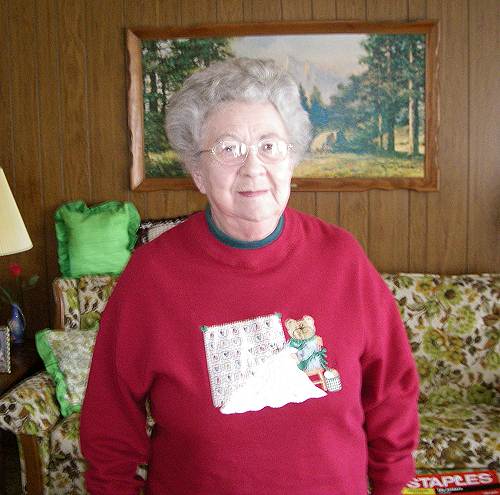
16 Helen Gibson
Helen gave me a wonderful tour which you can read about at this previous Progress Notes.
Helen has been an exceptional citizen having served in many volunteer organizations here but also she served her country during WWII. Her photo in uniform has been placed in honor of her in our WWII display at the Miller County Museum (photo 17).
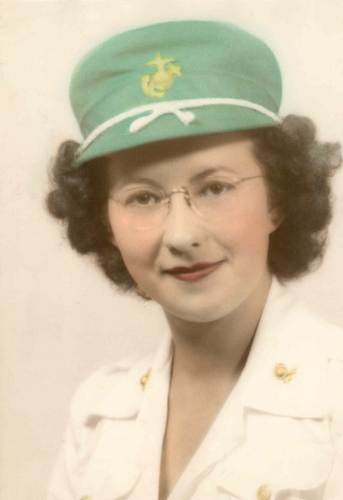
17 Portrait of Helen in Marine Corps
In 2007 she was selected for Patriot of the Month by the Missouri State Society of the Daughters of the American Revolution. Copied here is the narrative which accompanied her selection as Patriot of the Month:
Patriot of the Month
November 2006
Helen Bernadine Henley Gibson
Helen Henley joined the Marine Corps on December 3, 1943, at the age of 22 and served until July 26, 1945. She was sent to boot camp at Camp Lejeune, North Carolina. After boot camp, she was assigned to a specialist school at Cherry Point, North Carolina, to learn Marine aviation. She became an instructor teaching fighter pilots to shoot down enemy aircraft. Helen was ninth in a class of 21. She was classified as a gun air instructor and was sent to Aviation Women’s Reserve Squadron 3 M.C.S.S. in El Centro, California. Her class was the fighter pilot’s last stop on his way overseas.
Helen met her husband while in the Marine Corps. They married and moved back to the family farm. Helen worked for the Missouri State Department of Revenue as a cashier for over 18 years. She also worked in the disbursement section of the Missouri State Treasurer’s Office for 10 years
Helen is a member of the Eldon Chapter DAR, the Miller County Historical Society, the Eugene Chapter #386 Order of the Eastern Star, the Association of Retired Missouri State Employees, and the Spring Garden Baptist Church. She is a past member of the Ladies Auxiliary to the VFW and the Eugene Country Club. She attends Women Veterans meetings at the Veteran’s Hospital, works at the Miller County Courthouse counting absentee ballots each election, and writes an article for the Eldon paper each week.
Helen has two sons, who both served in th military during Viet Nam, five grandchildren, and six great grandchildren. Her hobbies include gardening, cooking, crafts, quilting, scrap booking, and bird watching (Helen says she has health problems and can no longer be as active as she once was.)
Delores Brondel nominated Helen for Patriot of the Month. Delores wrote that Helen accepts any task assigned to her with willingness. Helen is a member of the DAR Service for Veterans Committee and sews beautiful lap robes and other comfort items for the veterans. She also cuts out the cancelled postage stamps, which are used by the Department of Veterans Affairs in physical therapy.
Delores Brondel and the members of the Eldon Chapter are proud to nominate Helen Henley Gibson for Patriot of the Month.
Alan Wright, author of the book Murder on Rouse Hill who is an occasional contributor to our website, was raised near Eugene and knew Helen Gibson (photo 18).
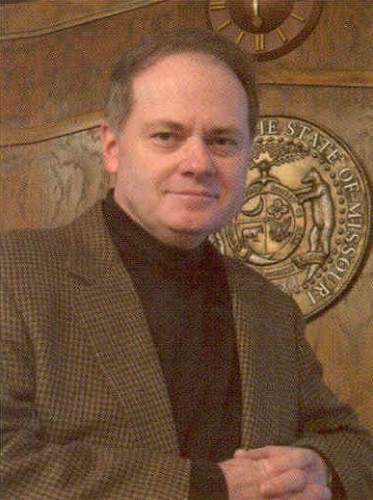
18 Alan Wright
Recently, he sent me a note about a book he had read which honored a WWII hero named John Basilone. Alan said that reading the book made him think about Helen Gibson and her service for our country. Here is what Alan wrote:
Joe:
I recently happened upon contributed material from Helen Gibson in a couple of different pieces about the Gageville school and lead mining in that area of Miller County I knew both of Helen's sons at Eugene High School. As I understand it, in WWII, she was a lady Marine who taught pilots in training how to aim and fire their on-board machine guns. That was a pretty important job. The article made me think of her, and this week I sent her a copy of Jim Brady's book about Marine WWII hero John Basilone.
In 1942, Basilone won the Medal of Honor on Guadalcanal. He was then brought home to help sell war bonds and hobnobbed with movie starlets, did interviews, and rode in parades for a year or two. He then demanded to be sent back to the Pacific. Shortly thereafter, he was killed on Iwo Jima while attacking a Japanese bunker. Before shipping out, he had married a young enlisted Marine named Lena Riggi, not that much different than Helen at the time.
In one of the classiest acts I've heard of, Basilone's wife sent the $10,000 government death benefit, to which she was entitled, to Basilone's mom. That is the equivalent of about $140,000 now. Within a year, standing tall in her Marine uniform, she christened a new navy destroyer, the USS Basilone, named for her husband.
The John and Lena Basilone story is so compelling, and with Helen Gibson serving during the same time as a lady Marine from Miller County, I thought maybe your readers might like to learn about them.
Lena's monument is at the national cemetery in Riverside, CA.
She is buried some 3,000 miles from where John rests in Arlington National Cemetery. She could have been buried with John, but "just didn't want to cause any trouble." I know that there have been other Medal of Honor winners for whom ships were built and named, but I doubt any were ever christened by a spouse, still on active duty, in the same service in the same war. In my book, they are both American heroes. Lena never married again and spent much of her life supporting veteran's causes.
Helen Gibson called recently to thank me for the book about John Basilone that I had sent her. She will soon be 90, has had cancer surgery, and her physicians are watching her pretty closely. But, as usual, she sounded up-beat and optimistic. "Semper Fi" all the way.
As far as Helen knows, she was the only woman born and raised in Miller County who served in the Marine Corps in WWII. She mentioned that the lady (She couldn't recall her name.) who, along with her husband, once ran the old "El Rancho" was a WWII Marine, but was not originally from Miller County.
Note: The lady to whom Alan refers was Helen Biselx, who with her husband Frank, was one of the owners of the old El Rancho Resort. You can read more about her war time experience at this previous Progress Notes.
Helen was stationed at Camp Lejeune, N.C. for "basic" and Marine Corps Air Station, Cherry Point, SC. At the latter, after taking training as an aerial gunnery instructor, she helped teach hundreds of Marine fighter pilots the techniques of aircraft gunnery. They used simulators that permitted them to practice firing their .50 caliber machine guns at "moving" targets. She agreed that the skills she helped teach likely resulted in many Japanese planes being shot down in the Pacific war. She said that sometimes, when there weren't any pilots scheduled for training, she would get bored and go over to the mess hall and assist the cooks. Volunteering for extra duty? That doesn't sound like anything I remember from my Army days.
Helen Gibson was never stationed at Camp Pendleton, the big Marine base in California, thus never saw nor met Sgt. John Basilone or the woman he wed, Sgt. Lena Riggi, but greatly admires them both.
Her WWII uniform, and much memorabilia, were lost in a fire that burned her mom and dad's old farmhouse near Gageville. Although, I believe she said the MCHS Museum does have an item or two.
Alan Terry Wright
St. Louis, MO and Pawleys Island, SC
Thanks Alan for this interesting story and the tribute to our Miller County WWII heroine, Helen Gibson.
The Miller County Museum was host to members of the Jefferson City organization, Learning in Retirement Inc., on two different occasions recently. Each group was made up of more than forty members of retirees who regularly participate in activities which provide them new learning opportunities and exposure to interesting and different experiences. The organization is associated with Lincoln University and its affiliation with the Elderhostel Institute Network. The itinerary included a guided tour of Tuscumbia as well as the museum. Prior to its arrival in Tuscumbia the group was given a tour of the St. Lawrence Catholic Church in St. Elizabeth by Miller County Historical Society member Cyrilla Doerhoff. While in St. Elizabeth the members enjoyed a lunch at the well-known restaurant, “Miss Kitty’s Café.” Coordinator of the members was Vera Rust of Jefferson City who gave our museum a very nice donation after the tour (photo 24).
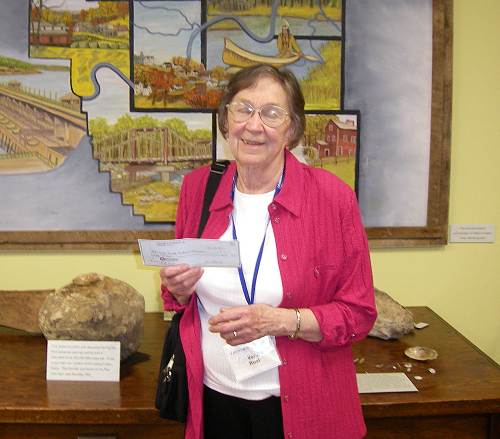
24 Vera Rust
When the group arrived in Tuscumbia I met the bus at the Merten’s Station at the intersection of Highway 52/17. Here is a photo of the group on the bus (photo 25).
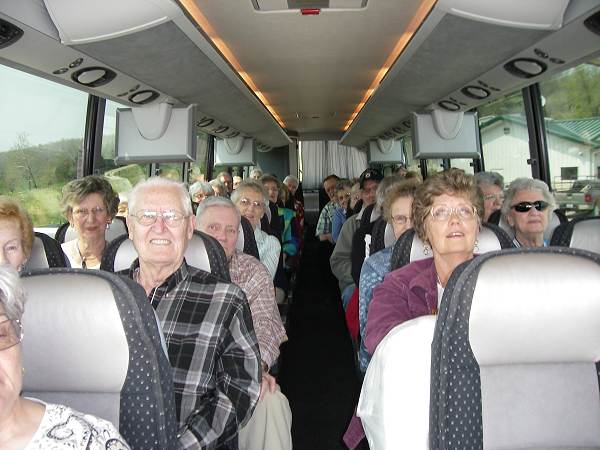
25 On the Bus with Learning and Retirement Group
I showed our guests the landing on the Osage River in the middle of Tuscumbia where the steamboats arrived and departed (photo 26), the old bank and Presbyterian Church (photo 27), the old barber shop (photo 28), and the remains the old Woodman Hall building which burned several years ago (photo 29).
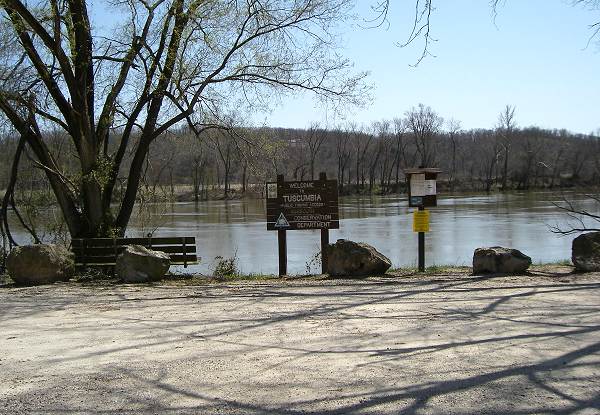
26 River Landing
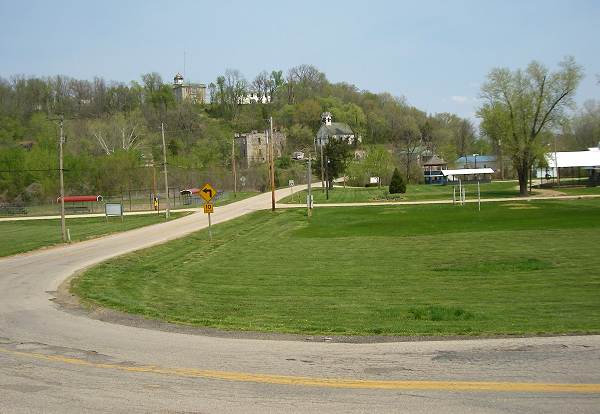
27 Goosebottom lookng East toward Bank, Church and Courthouse
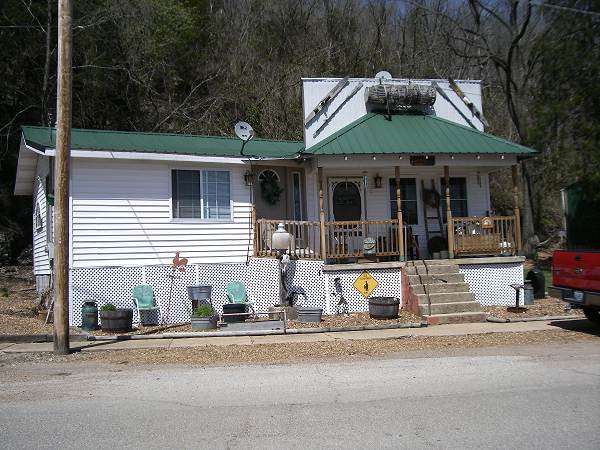
28 Original Barber Shop
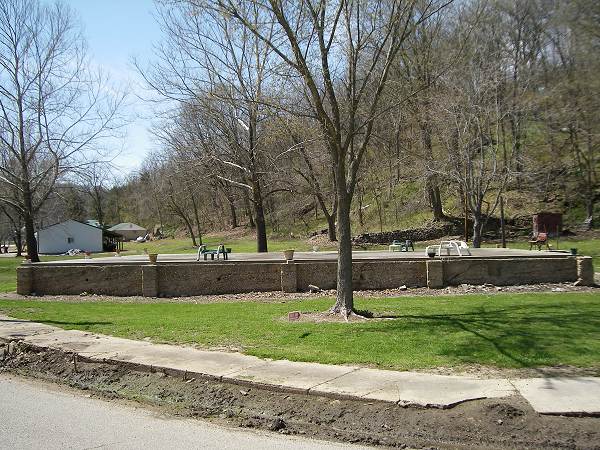
29 Old Woodman Fellow Hall Foundation
I also showed them the former home of Steamboat Captain Bob Marshall, now quite deteriorated, and the former home of George Hauenstein who was one who built the well known Hauenstein’s General Store (photos 30 and 31).
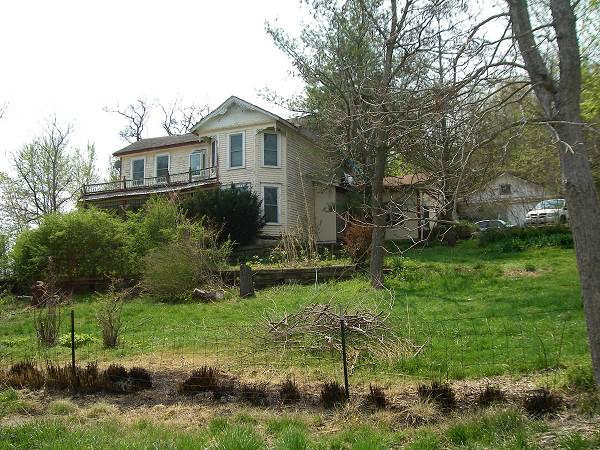
30 Bob Marshall Home
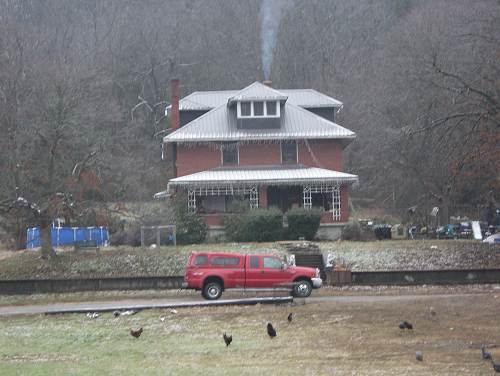
31 George and Ida Hauenstein Home
The most interesting thing to the group was the long 117 steps stairway up the hill to the old Courthouse (photo 32).
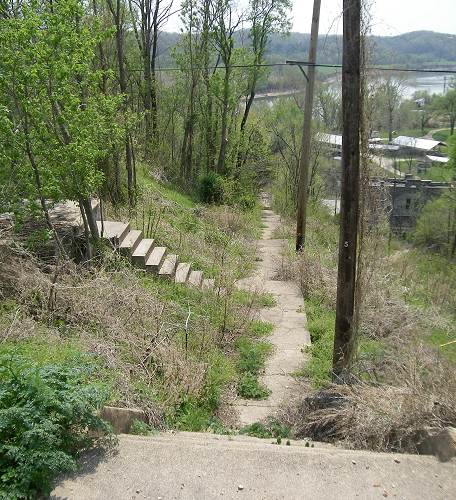
32 Steps up the Hill
They also were interested in the old bandstand in the Riverside Park, one of the oldest buildings still standing in town (photo 33).
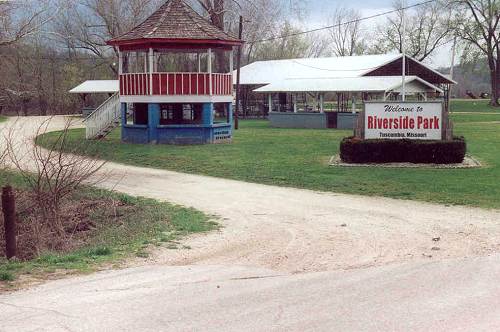
33 Bandstand in Tuscumbia
On the other side of town they were interested to see the large home built by J. Edward Kallenbach, who with his half brother John Kallenbach, was a blacksmith and wagon maker (photo 34).
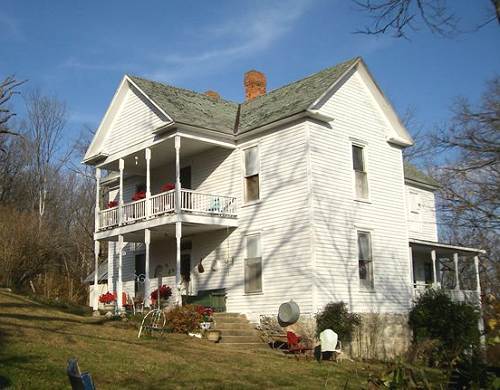
34 John Edward Kallenbach Home in Tuscumbia
On top of the hill I showed them the old Courthouse and remarked that because of a lack of funds in 1910 when the building was constructed, the clock in the dome of the Courthouse was not real and had painted hands (photo 35).
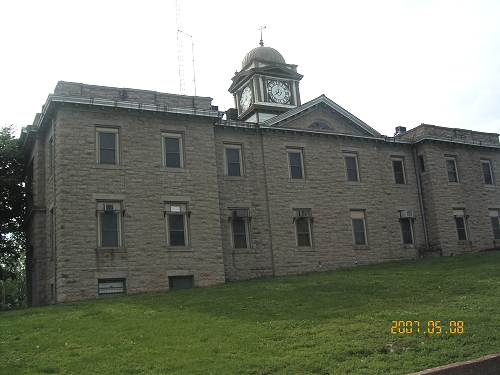
35 Courthouse Clock
However, I told them that the clock was exactly accurate twice a day, something the new courthouse clock cannot claim, even if it is real.
From the top of the courthouse hill they relished the view down toward the river valley where they could see the George Hauenstein home once again but a long way off down below (photo 36).
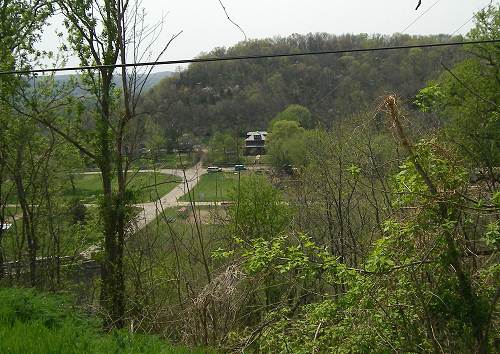
36 George Hauenstein Home from Courthouse Hill Top
I told several jokes but the biggest laugh came when the bus made a sudden turn and I fell backwards down the steps to the door and ended up with my feet sticking straight up in the air, my back and head down below the stairs at the bottom of the door.
At the museum the group departed the bus to tour the museum and our cabins. Here is a photo of the huge bus in which they came to town (photo 37):
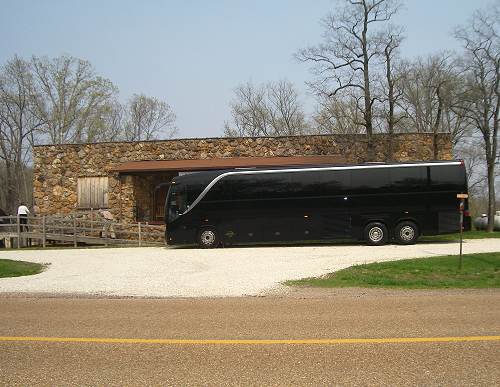
37 Huge Bus
Inside the museum volunteers were present to answer questions. Here is a photo of one of our volunteers, Sharon Holder (photo 38):
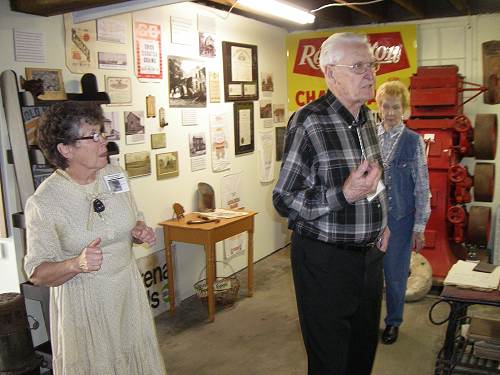
38 Sharon Holder, Volunteer
The group enjoyed a rest on the porch where a cool breeze was present (photo 39).
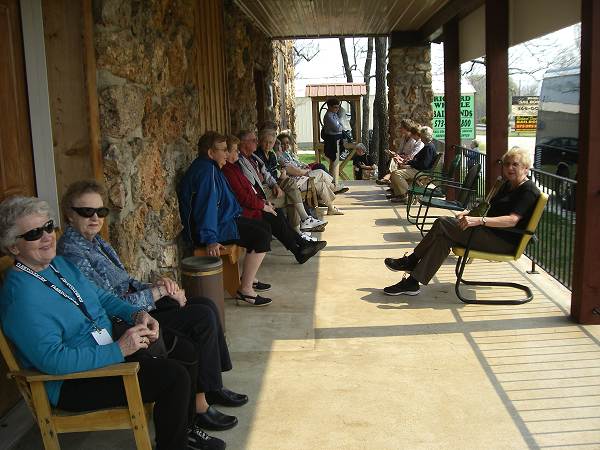
39 Resting on Porch
The mission of Learning in Retirement Inc., through its partnership with Lincoln University and its affiliation with Elderhostel Institute Network, is to provide continuing learning opportunities and to promote sharing of ideas, knowledge, and experience for retirees and or seniors in Jefferson City and the surrounding areas. A love of learning with exceptional people in engaging environments creates memorable experiences and brings the members together encouraging new friendships and renewing of old ones.
You can learn more about Learning in Retirement at this website.
That’s all for this week.
 Joe Pryor
Previous article links are in a dropdown menu at the top of all of the pages.
|

